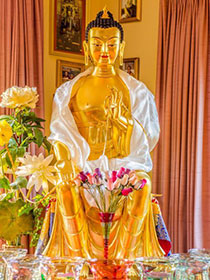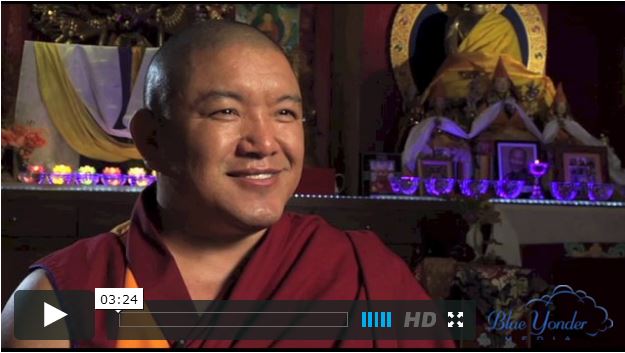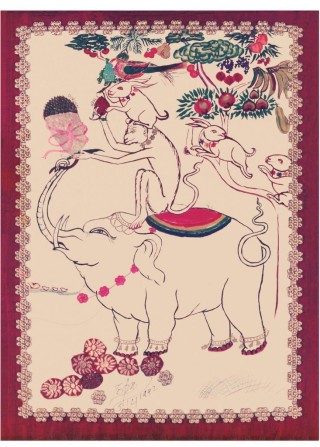- Home
- FPMT Homepage
Foundation for the Preservation of the Mahayana Tradition
The FPMT is an organization devoted to preserving and spreading Mahayana Buddhism worldwide by creating opportunities to listen, reflect, meditate, practice and actualize the unmistaken teachings of the Buddha and based on that experience spreading the Dharma to sentient beings. We provide integrated education through which people’s minds and hearts can be transformed into their highest potential for the benefit of others, inspired by an attitude of universal responsibility and service. We are committed to creating harmonious environments and helping all beings develop their full potential of infinite wisdom and compassion. Our organization is based on the Buddhist tradition of Lama Tsongkhapa of Tibet as taught to us by our founders Lama Thubten Yeshe and Lama Thubten Zopa Rinpoche.
- Willkommen
Die Stiftung zur Erhaltung der Mahayana Tradition (FPMT) ist eine Organisation, die sich weltweit für die Erhaltung und Verbreitung des Mahayana-Buddhismus einsetzt, indem sie Möglichkeiten schafft, den makellosen Lehren des Buddha zuzuhören, über sie zur reflektieren und zu meditieren und auf der Grundlage dieser Erfahrung das Dharma unter den Lebewesen zu verbreiten.
Wir bieten integrierte Schulungswege an, durch denen der Geist und das Herz der Menschen in ihr höchstes Potential verwandelt werden zum Wohl der anderen – inspiriert durch eine Haltung der universellen Verantwortung und dem Wunsch zu dienen. Wir haben uns verpflichtet, harmonische Umgebungen zu schaffen und allen Wesen zu helfen, ihr volles Potenzial unendlicher Weisheit und grenzenlosen Mitgefühls zu verwirklichen.
Unsere Organisation basiert auf der buddhistischen Tradition von Lama Tsongkhapa von Tibet, so wie sie uns von unseren Gründern Lama Thubten Yeshe und Lama Thubten Zopa Rinpoche gelehrt wird.
- Bienvenidos
La Fundación para la preservación de la tradición Mahayana (FPMT) es una organización que se dedica a preservar y difundir el budismo Mahayana en todo el mundo, creando oportunidades para escuchar, reflexionar, meditar, practicar y actualizar las enseñanzas inconfundibles de Buda y en base a esa experiencia difundir el Dharma a los seres.
Proporcionamos una educación integrada a través de la cual las mentes y los corazones de las personas se pueden transformar en su mayor potencial para el beneficio de los demás, inspirados por una actitud de responsabilidad y servicio universales. Estamos comprometidos a crear ambientes armoniosos y ayudar a todos los seres a desarrollar todo su potencial de infinita sabiduría y compasión.
Nuestra organización se basa en la tradición budista de Lama Tsongkhapa del Tíbet como nos lo enseñaron nuestros fundadores Lama Thubten Yeshe y Lama Zopa Rinpoche.
A continuación puede ver una lista de los centros y sus páginas web en su lengua preferida.
- Bienvenue
L’organisation de la FPMT a pour vocation la préservation et la diffusion du bouddhisme du mahayana dans le monde entier. Elle offre l’opportunité d’écouter, de réfléchir, de méditer, de pratiquer et de réaliser les enseignements excellents du Bouddha, pour ensuite transmettre le Dharma à tous les êtres. Nous proposons une formation intégrée grâce à laquelle le cœur et l’esprit de chacun peuvent accomplir leur potentiel le plus élevé pour le bien d’autrui, inspirés par le sens du service et une responsabilité universelle. Nous nous engageons à créer un environnement harmonieux et à aider tous les êtres à épanouir leur potentiel illimité de compassion et de sagesse. Notre organisation s’appuie sur la tradition guéloukpa de Lama Tsongkhapa du Tibet, telle qu’elle a été enseignée par nos fondateurs Lama Thoubtèn Yéshé et Lama Zopa Rinpoché.
Visitez le site de notre Editions Mahayana pour les traductions, conseils et nouvelles du Bureau international en français.
Voici une liste de centres et de leurs sites dans votre langue préférée
- Benvenuto
L’FPMT è un organizzazione il cui scopo è preservare e diffondere il Buddhismo Mahayana nel mondo, creando occasioni di ascolto, riflessione, meditazione e pratica dei perfetti insegnamenti del Buddha, al fine di attualizzare e diffondere il Dharma fra tutti gli esseri senzienti.
Offriamo un’educazione integrata, che può trasformare la mente e i cuori delle persone nel loro massimo potenziale, per il beneficio di tutti gli esseri, ispirati da un’attitudine di responsabilità universale e di servizio.
Il nostro obiettivo è quello di creare contesti armoniosi e aiutare tutti gli esseri a sviluppare in modo completo le proprie potenzialità di infinita saggezza e compassione.
La nostra organizzazione si basa sulla tradizione buddhista di Lama Tsongkhapa del Tibet, così come ci è stata insegnata dai nostri fondatori Lama Thubten Yeshe e Lama Zopa Rinpoche.
Di seguito potete trovare un elenco dei centri e dei loro siti nella lingua da voi prescelta.
- 欢迎 / 歡迎
简体中文
“护持大乘法脉基金会”( 英文简称:FPMT。全名:Foundation for the Preservation of the Mahayana Tradition) 是一个致力于护持和弘扬大乘佛法的国际佛教组织。我们提供听闻,思维,禅修,修行和实证佛陀无误教法的机会,以便让一切众生都能够享受佛法的指引和滋润。
我们全力创造和谐融洽的环境, 为人们提供解行并重的完整佛法教育,以便启发内在的环宇悲心及责任心,并开发内心所蕴藏的巨大潜能 — 无限的智慧与悲心 — 以便利益和服务一切有情。
FPMT的创办人是图腾耶喜喇嘛和喇嘛梭巴仁波切。我们所修习的是由两位上师所教导的,西藏喀巴大师的佛法传承。
繁體中文
護持大乘法脈基金會”( 英文簡稱:FPMT。全名:Found
ation for the Preservation of the Mahayana Tradition ) 是一個致力於護持和弘揚大乘佛法的國際佛教組織。我們提供聽聞, 思維,禪修,修行和實證佛陀無誤教法的機會,以便讓一切眾生都能 夠享受佛法的指引和滋潤。 我們全力創造和諧融洽的環境,
為人們提供解行並重的完整佛法教育,以便啟發內在的環宇悲心及責 任心,並開發內心所蘊藏的巨大潛能 — 無限的智慧與悲心 – – 以便利益和服務一切有情。 FPMT的創辦人是圖騰耶喜喇嘛和喇嘛梭巴仁波切。
我們所修習的是由兩位上師所教導的,西藏喀巴大師的佛法傳承。 察看道场信息:
- FPMT Homepage
- News/Media
-
- Study & Practice
-
-
- About FPMT Education Services
- Latest News
- Programs
- New to Buddhism?
- Buddhist Mind Science: Activating Your Potential
- Heart Advice for Death and Dying
- Discovering Buddhism
- Living in the Path
- Exploring Buddhism
- FPMT Basic Program
- FPMT Masters Program
- FPMT In-Depth Meditation Training
- Maitripa College
- Lotsawa Rinchen Zangpo Translator Program
- Universal Education for Compassion & Wisdom
- Online Learning Center
-
- Prayers & Practice Materials
- Overview of Prayers & Practices
- Full Catalogue of Prayers & Practice Materials
- Explore Popular Topics
- Benefiting Animals
- Chenrezig Resources
- Death & Dying Resources
- Lama Chopa (Guru Puja)
- Lama Zopa Rinpoche: Compendium of Precious Instructions
- Lama Zopa Rinpoche: Life Practice Advice
- Lama Zopa Rinpoche Practice Series
- Lamrim Resources
- Mantras
- Prayer Book Updates
- Purification Practices
- Sutras
- Thought Transformation (Lojong)
- Audio Materials
- Dharma Dates - Tibetan Calendar
- Translation Services
- Publishing Services
- Ways to Offer Support
- Prayers & Practice Materials
-
- Teachings and Advice
- Find Teachings and Advice
- Lama Zopa Rinpoche Advice Page
- Lama Zopa Rinpoche: Compendium of Precious Instructions
- Lama Zopa Rinpoche Video Teachings
- ༧སྐྱབས་རྗེ་བཟོད་པ་རིན་པོ་ཆེ་མཆོག་ནས་སྩལ་བའི་བཀའ་སློབ་བརྙན་འཕྲིན།
- Podcasts
- Lama Yeshe Wisdom Archive
- Buddhism FAQ
- Dharma for Young People
- Resources on Holy Objects
- Teachings and Advice
-
-
*If a menu item has a submenu clicking once will expand the menu clicking twice will open the page.
-
-
- Centers
-
- Teachers
-
- Projects
-
-
-
-
*If a menu item has a submenu clicking once will expand the menu clicking twice will open the page.
-
-
- FPMT
-
-
-
-
-
The reason we are unhappy is because we have extreme craving for sense objects – samsaric objects – and we grasp at them. We are seeking to solve our problems, but we are not seeking in the right place. The right place is our ego-grasping.
Lama Thubten Yeshe
-
-
-
- Shop
-
-
-
The Foundation Store is FPMT’s online shop and features a vast selection of Buddhist study and practice materials written or recommended by our lineage gurus. These items include homestudy programs, prayers and practices in PDF or eBook format, materials for children, and other resources to support practitioners.
Items displayed in the shop are made available for Dharma practice and educational purposes, and never for the purpose of profiting from their sale. Please read FPMT Foundation Store Policy Regarding Dharma Items for more information.
-
-
Mandala
14
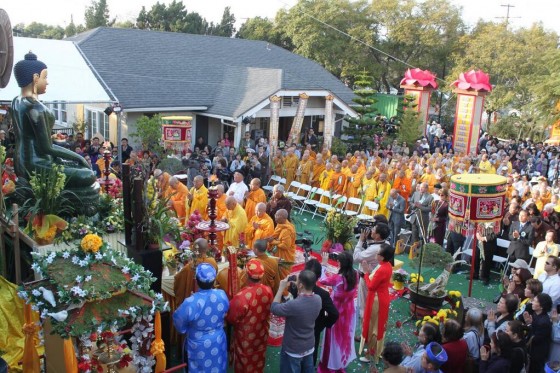
Opening ceremony for Jade Buddha for Universal Peace’s visit to Trung Tam Phat Giao To Dinh Minh Dang Quang in Santa Ana, California, January 2014. Photos courtesy of Ian Green / Jade Buddha via Twitter.
Among the many holy object projects created by FPMT students, the Jade Buddha for Universal Peace stands out as a truly international project. Australian student Ian Green oversaw the creation of the Jade Buddha from the enormous Polar Pride jade boulder found in British Columbia, Canada. The boulder was carved in Thailand and modeled on the Buddha statue inside the Mahabodhi Stupa in Bodhgaya, India. Since 2009, it has been touring the world.
In the new issue of Mandala, we report on the Jade Buddha’s current tour of North America, which began on January 2 at the Vietnamese Buddhist Congregation of the United States, Trung Tam Phat Giao To Dinh Minh Dang Quang in Santa Ana, California.
Read the complete story with our online edition for Mandala April-June 2014.
Mandala brings you news of Lama Zopa Rinpoche and of activities, teachings and events from over 160 FPMT centers, projects and services around the globe. If you like what you read on Mandala, consider becoming a Friend of FPMT, which supports our work.
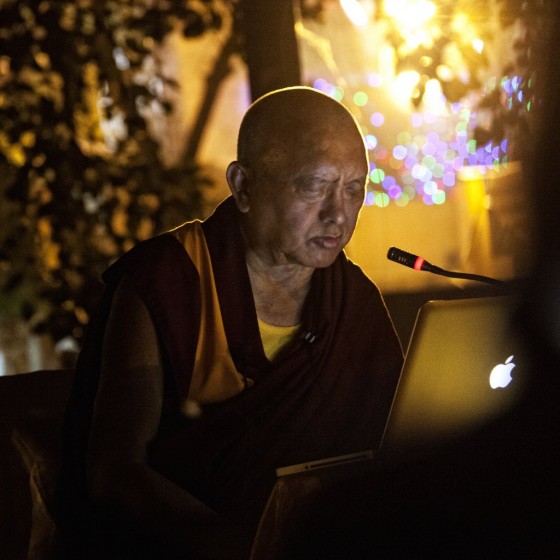
Lama Zopa Rinpoche reading the Sutra of Golden Light at Mahabodhi Temple, Bodhgaya, India, March 2014. Photo by Andy Melnic.
Our hearts and prayers go out to all the people on Malaysia Airlines flight 370 as well as all their families. FPMT spiritual director Lama Zopa Rinpoche recently gave advice on what we can do for the 239 people who were on the flight:
- To recite the Sutra of Golden Light mindfully and Medicine Buddha puja.
- In addition, to recite 100,000 Names of Buddha. As this is only in Tibetan, this recitation could be sponsored.
Lama Zopa Rinpoche is the spiritual director of the Foundation for the Preservation of Mahayana Tradition (FPMT), an organization dedicated to preserving Mahayana Buddhism through offering the Buddha’s authentic teachings and to facilitating reflection, meditation, practice and the opportunity to actualize and directly experience the Buddha’s teachings. Sign up to receive news and updates.
- Tagged: flying, lama zopa rinpoche, malaysia, mandala
- 0
12
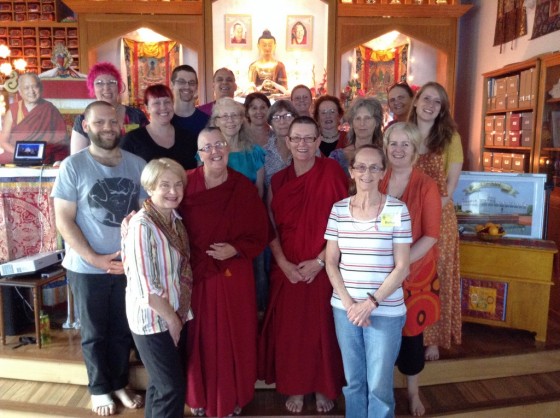
The participants of Langri Tangpa Centre’s first virtual pilgrimage, November 2013. Photo courtesy of Langri Tangpa Centre.
Miffi Maxmillion, spiritual program coordinator of Langri Tanga Centre in Brisbane, Australia, shares an innovative way to bring the practice of pilgrimage to students unable to travel:
Lama Zopa Rinpoche has often talked about the benefits of pilgrimage, but not all of us are so lucky to go on one. We took Rinpoche’s advice, the Discovering Buddhism pilgrimage notes, and made a fantastic day of it!
Over 20 pilgrims joined in our virtual adventure around the holy Buddhist sites. We viewed a selection of slides from each of the eight Buddhist holy places. Some photos from the 1700s, when they were still mounds of dirt and ruins with trees growing out the top, and some more recent and in the process of restoration. Students who had personally visited these sites shared their impressions, and we discovered details about the lives of the Buddha and his disciples that made them incredibly vivid and immediate – what a bunch of courageous and eccentric practitioners!
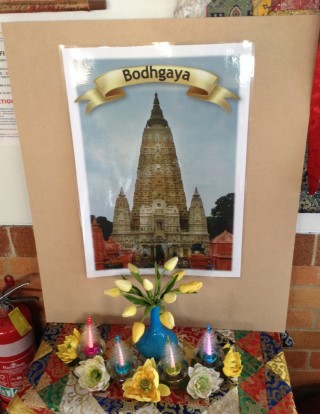
Students are able to visit “Bodhgaya” without leaving Australia, November 2013. Photo courtesy of Langri Tangpa Centre.
As we traveled to the eight altars set up around our gompa (just a few feet apart, but we did move all the chairs!), we did prostrations, made offerings and read the sutra associated with the site. (We burned our fingers on the light offerings when reciting the Angulimala Sutra!) By the time we got to Sankashya, the place where Buddha descended from Tushita, the afternoon storm had rolled in, thunder was shaking the heavens, and we were sure the celestial ladder was about to descend right there in front of us! We ended 15 minutes earlier than planned, with personal dedications and a heartfelt wish held by all to travel in the Buddha’s footsteps all the way to enlightenment. We’ve put together a pilgrimage kit now, and I can’t recommend it enough – one of the highlights of 2013.
Mandala brings you news of Lama Zopa Rinpoche and of activities, teachings and events from over 160 FPMT centers, projects and services around the globe. If you like what you read on Mandala, consider becoming a Friend of FPMT, which supports our work.
- Tagged: langri tangpa centre, mandala, pilgrimage
- 0
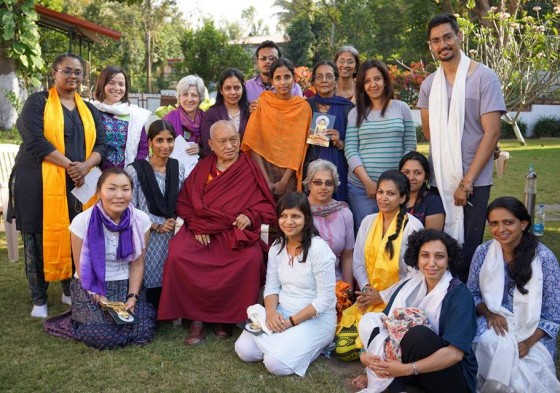
Lama Zopa Rinpoche with Choe Khor Sum Ling students at the Jangchup Lamrim teachings, Sera Je Monastery, India, December 2013. Photo by Bill Kane.
Dee Shekhar, member of Choe Khor Sum Ling in Bangalore, India, shares news from the December 2013 Jangchup Lamrim teachings with His Holiness the Dalai Lama at Sera Je Monastery in South India:
The month of December proved to be doubly important for the members of Choe Khor Sum Ling. We were very blessed to receive Kyabje Lama Zopa Rinpoche in Bangalore and two members of our center had the unique blessing of hosting Rinpoche and his team for dinner.
On December 24, 2013, the streets of Bylakuppe were thronged with people with khatas for nearly 10 kilometers [6 miles] to welcome His Holiness the Dalai Lama, who began the second installation of incredible Jangchup Lamrim teachings on December 25, 2013. Nearly 30,000 people from different countries waited to see and hear His Holiness teach. The monasteries were kind enough to accommodate people traveling from far and wide.
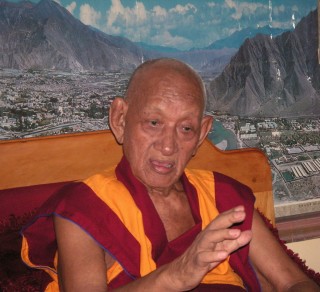
Khensur Lobsang Tsering, the inaugural speaker at Choe Khor Sum Ling’s founding, was also at the Jangchup Lamrim teachings, Sera Je Monastery, India, December 2013. Photo by Shanti Y.
His Holiness began the teaching at Sera Je Monastery by making his students see the presence of spiritual thought in the world and thanking India for its contribution to Buddhism and also by grounding us in the reality of the 21st century. His Holiness gave the lung and commentary on The Swift Path, The Easy Path, The Essence of Refined Gold, The Essence of Nectar, and The Sacred Words of Manjushri. His Holiness then taught extensively on the greatness of the teachings, the qualities of a teacher, the topic of meditation, bodhichitta – aspiring and engaging, suffering and the hell realms.
His Holiness encouraged students to study Je Tsongkhapa’s In Praise of Dependent Origination on the day of his long life puja. Lama Zopa Rinpoche gave a lung of the text at the Tsawa Khangsten.
On the last day of the teaching, His Holiness bestowed the Avalokiteshvara initiation in connection to aspiring bodhichitta on all his assembled students. The teachings ended with the promise of meeting later this year to study Kyabje Pabongka Rinpoche’s Liberation in the Palm of Your Hand.
Choe Khor Sum Ling members also had the great fortune of making khata offerings to various buddhas and great teachers such as Kyabje Lama Zopa Rinpoche, Khadro-la, Khangser Rinpoche, Ribur Rinpoche, Dagri Rinpoche, Kyongla Rato Rinpoche and His Eminence Kyabje Choden Rinpoche, Khensur Lobsang Tsering and of course His Eminence the 7th Ling Rinpoche, who organized the teachings.
It was a blessing to be amidst all the great teachers and scholarly monks and nuns. All in all, this was a great blessing of pilgrimage for Choe Khor Sum Ling students.
Mandala brings you news of Lama Zopa Rinpoche and of activities, teachings and events from over 160 FPMT centers, projects and services around the globe. If you like what you read on Mandala, consider becoming a Friend of FPMT, which supports our work.
- Tagged: choe khor sum ling, jangchup lamrim, mandala
- 0
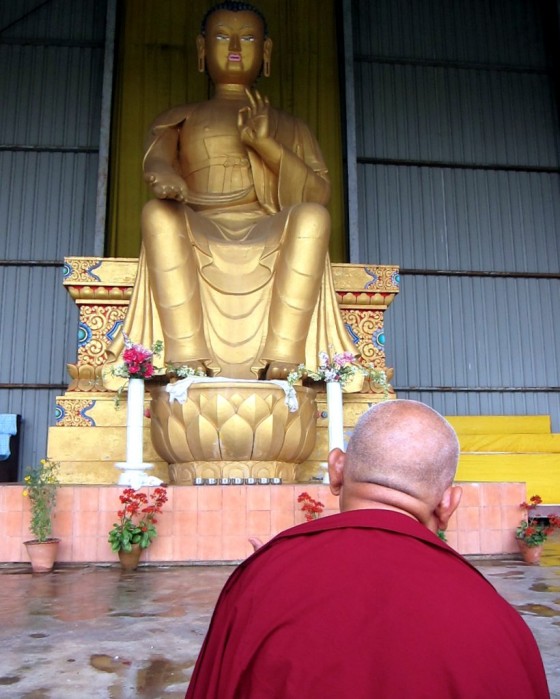
Lama Zopa Rinpoche doing prayers in front of the 24-foot Maitreya Buddha statue on the Maitreya Project land in Bodhgaya, India, February, 2014. Photo by Ven. Sarah Thresher.
While Rinpoche has been staying in Bodhgaya, he visited Maitreya Project land and offered prayers with members of the Maitreya team. Rinpoche has written a letter explaining that there are now two Maitreya Projects. For more, see this announcement.
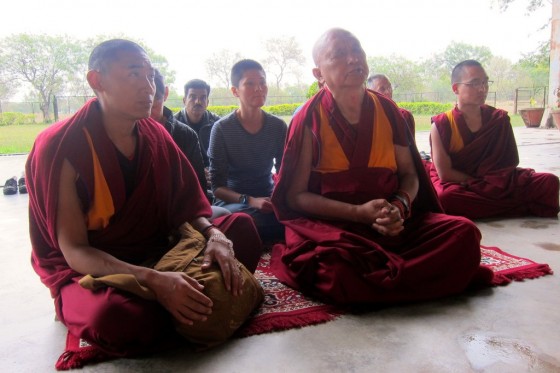
Lama Zopa Rinpoche doing prayers in front of the 24-foot Maitreya Buddha statue on Maitreya Project land in Bodhgaya, India, February 2014. Photo by Ven. Sarah Thresher.
Learn more about Lama Zopa Rinpoche, spiritual director of the Foundation for the Preservation of Mahayana Tradition (FPMT), and Rinpoche’s vision for a better world. Sign up to receive news and updates.
6
Wisdom and Maturity
By Ven. Chönyi Taylor
We all know what wisdom is, yet we find it hard to define. It is not knowledge, although knowledge is one of its qualities. It is not ethics, although that also is a quality of wisdom. There are countless images that appear on a Google image search. Some are trite, some funny and some are profound. Yet there is some part of us that recognizes wisdom when we see it.
Mostly wisdom is depicted in male form, but there is a question that does its rounds on the internet: what if there were three wise women rather than three wise men? They would have asked directions, arrived on time, helped deliver the baby, cleaned the stable, made a casserole, brought practical gifts and there would be peace on earth. A woman’s wisdom is more likely to be practical.
In Tibetan Buddhism, there are five wisdoms identified, one for each of the tantric families of deities. They are the mirror-like wisdom which simply recognizes things as they are; the wisdom of equality which recognizes that feelings are just that and nothing else; the wisdom of discrimination which allows us to recognize things and give them labels; the wisdom of accomplishment which enables us to achieve our goals; and our own innate wisdom, our dharmadhatu, which enables us to recognize wisdom when we meet it.
These are not just Buddhist or Tibetan qualities. Nor are they specifically male or female. Wise people, regardless of gender, would have all these wisdom qualities well developed. We can find a Western version of wisdom in Abraham Maslow’s list of the qualities of self-actualized (wise) people. He also adds a few more in addition to our five wisdoms: spontaneity, comfort with solitude, a freshness of appreciation. Wise people usually know first-hand what Maslow called “peak experiences,” that experience of being at one with all things, of being in the “flow.” Wisdom seems to have a spiritual component as well.
And yet, even with all these qualities, there is a simplicity that we recognize in wise people, of humility, of gratitude, of their knowing they are just one in a network of beings who have contributed to that wisdom. They do not seek fame, or wealth, or praise or comfort from their wisdom. They are not trapped in a self-seeking ego.
The Stanford University Dictionary of Philosophy describes five different ways of understanding what it takes to be wise: (1) wisdom as epistemic humility, (2) wisdom as epistemic accuracy, (3) wisdom as knowledge, (4) a hybrid theory of wisdom, and (5) wisdom as rationality. All of these are different ways of understanding what wisdom really is. But Buddhism goes one step further, it has, as its central theme, the wisdom that overcomes our root ignorance, the wisdom realizing emptiness. The prajñaparamita.
Prajñaparamita means, literally, the “perfection of wisdom.” We know this perfection of wisdom in terms of the prajñaparamita texts such as the Heart Sutra. The ground of wisdom is the clear and experiential knowing of the truth of the lack of inherent existence. This is the ground from which all things dependently arise. When it is fully realized, it is the antidote to all our suffering. Prajñaparamita texts are the teaching on emptiness, a favorite topic of intellectuals who like the conundrums embedded in this study. And yet the depiction of Prajñaparamita in human form is not an intellectual male, but an older woman. She is not a sex object, but the mother of all the Buddhas. She is not a playful dakini, but a mature woman, one who has given birth to all the wisdom of all the buddhas.
We do not become wise just because our skin has become wrinkled and our hair white. But a life that is lived with wisdom and compassion will have a quality of maturity that we may not recognize in our rush to be young and trendy. To reach the realization of emptiness is not just a matter of having worked it out intellectually, but of living in a way in which the qualities of wisdom become fully developed. That is the psychological component of the realization of emptiness.
Prajñaparamita is the embodiment of a life of having given birth, of continual creativity, an example of a dignity that is only possible when a life has been lived with all the qualities of wisdom. She is a deity for the elderly.
Ven. Chönyi Taylor is a registered Foundational Buddhism FPMT teacher and an elder for the Discovering Buddhism at Home Course. She is the author of Enough! A Buddhist Approach to Working with Addictive Patterns (Snow Lion, 2010) and has been published in Mandala, Buddhadharma, Dharma Vision and Sangha Magazine. She is a founding member and member of the training committee of the Australian Association of Buddhist Counsellors and Psychotherapists and an Honorary Lecturer in the Discipline of Psychiatry at Sydney University.
- Tagged: mandala, prajnaparamita, wisdom
- 0
28
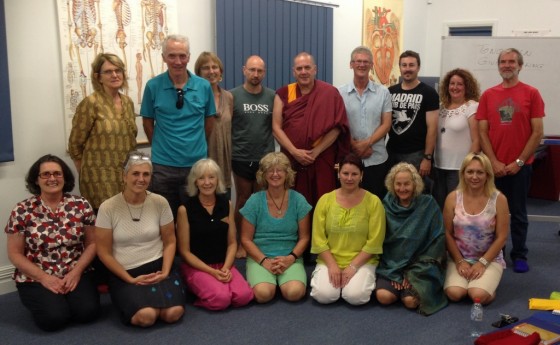
Ven. Lhundrup and the students of Shen Phen Ling Study Group, Victoria, Australia, February 2014. Photo courtesy of Shen Phen Ling.
Julie Klose, study group coordinator for Shen Phen Ling Study Group in northeast Victoria, Australia, offers this message of thanks to Australian monk Ven. Thubten Lhundrup from Thubten Shedrup Ling Monastery:
Shen Phen Ling Study Group in Albury/Wodonga has been blessed to have been receiving monthly teachings on Discovering Buddhism topics from Ven. Lhundrup for several years. His willingness to undertake the four-hour drive from Thubten Shedrup Ling Monastery in Bendigo to Wodonga, and an overnight stay each month, is amazing.
His dedication to sharing the Dharma with us has ensured the continued existence of our group and been of enormous benefit to us all. Although very sad to see him leave us for the time being, we wish him well for his studies in Dharamsala, India.
Mandala brings you news of Lama Zopa Rinpoche and of activities, teachings and events from over 160 FPMT centers, projects and services around the globe. If you like what you read on Mandala, consider becoming a Friend of FPMT, which supports our work.
- Tagged: mandala, shen phen ling study group
- 0

Dusum Sangay Guru Rinpoche statue, February 2014. Photo courtesy of Chandrakirti Tibetan Buddhist Meditation Centre.
Phillipa Rutherford, co-director of New Zealand’s Chandrakirti Tibetan Buddhist Meditation Centre, shares news about the successful completion of some of Lama Zopa Rinpoche’s advice:
We would like to let people know we have manifested a 2-meter (7-foot) Guru Rinpoche (Padmasambhava) statue and we are currently filling it and reorganizing the altar to fit it. This is Dusum Sangay Guru Rinpoche, the manifestation of Guru Rinpoche who dispels all obstacles and brings amazing success.
The statue was crafted in Nepal and Ani Fran at Kopan Monastery coordinated the production of it. We are very happy to have fulfilled this wish of our precious Kyabje Lama Zopa Rinpoche.
Mandala brings you news of Lama Zopa Rinpoche and of activities, teachings and events from over 160 FPMT centers, projects and services around the globe. If you like what you read on Mandala, consider becoming a Friend of FPMT, which supports our work.
- Tagged: chandrakirti centre, mandala, padmasambhava
- 0
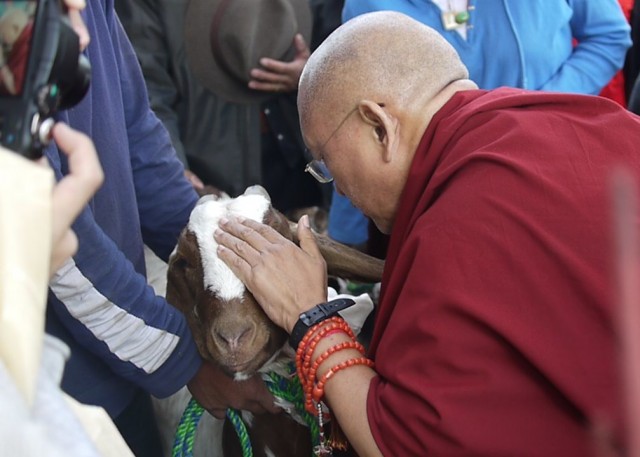
Lama Zopa Rinpoche blessing goat that he liberated, November 2010. Photos courtesy of Tania Duratovic and Phil Hunt.
Animal liberation is a practice often recommend to students for removing obstacles and to create the causes for a long life. With animal liberation, special care needs to be taken since the practice involves direct contact with living beings. Mandala has asked experienced animal liberation practitioners Tania Duratovic and Phil Hunt, coordinators of the Animal Liberation Sanctuary at Kopan Monastery, to share some of their practical knowledge of animal blessing and liberation practices for the January-March 2014 issue of Mandala.
Just what is the difference between animal liberation and an animal blessing? In the Buddhist sense, animal liberation is rescuing animals from impending death and then giving them Dharma by undertaking certain Buddhist practices including circumambulation and mantra recitation. It is usually done as a practice for long life and removing life obstacles, the merits being dedicated to someone else with specific obstacles, as well as to all living beings. An animal blessing, on the other hand, will include the same practices of circumambulation and mantra recitation but the animal involved has not necessarily been recently rescued from death, like someone’s pet.
Whichever activity you are undertaking, liberation or blessing, such Buddhist practices to help animals have many benefits. They help the animals, the people doing the practices and those for whom the practices are dedicated. However, there are also risks and with that comes responsibilities.
Of utmost importance is the care of those living beings by practitioners whether temporarily, prior to release into the wild, or long term as pets or at a sanctuary. While Buddhists believe the karmic benefit of doing these practices will be ongoing and perhaps have a greater effect in future lives, the welfare of the animals in this life is also critical. Animals should be handled and cared for as the “kind mother sentient beings” we are taught that they are, and as the fragile living creatures that share our planet and suffer physically, mentally and emotionally. …
From Mandala January-March 2014
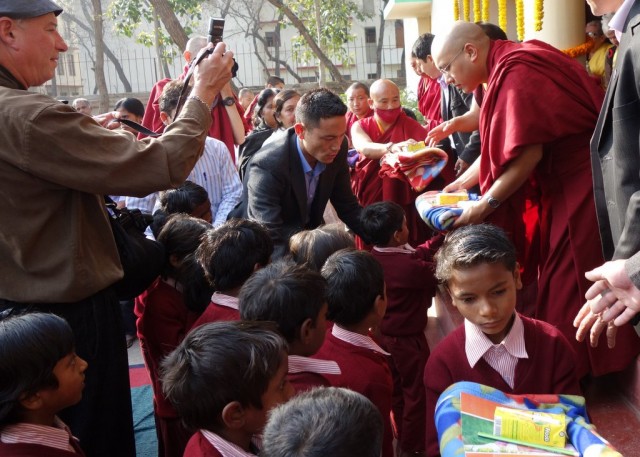
His Holiness the Karmapa offers gifts to Maitreya School children, Bodhgaya, India, January 31, 2014. Photo by Ven. Roger Kunsang.
His Holiness the Karmapa visited Maitreya School and Root Institute in Bodhgaya, India, on January 31. Lama Zopa Rinpoche was also at Root Institute and welcomed His Holiness.
The Maitreya School is a project of Root Institute and offers children a well rounded education that includes instruction in compassion, honesty and loving-kindness as emphasized by the 16 Guidelines, a Universal Education for Compassion and Wisdom program.
While visiting the school, His Holiness the Karmapa gave a talk to more than 100 Maitreya School students and teachers and offered the children gifts. His Holiness also gave a talk at Root Institute.
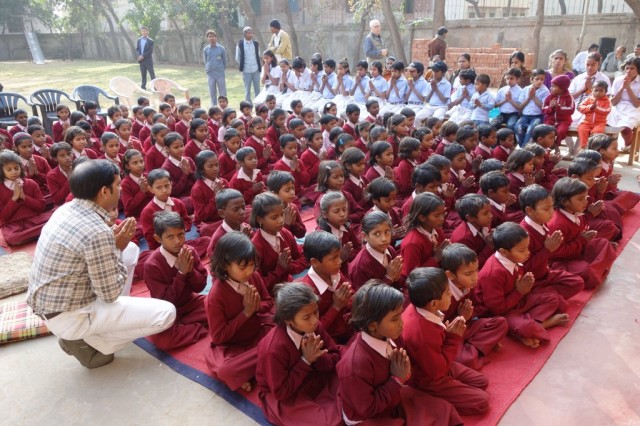
Maitreya School children waiting for a talk by His Holiness the Karmapa, Bodhgaya, January 31, 2014. Photo by Ven. Roger Kunsang.
Mandala brings you news of Lama Zopa Rinpoche and of activities, teachings and events from over 160 FPMT centers, projects and services around the globe. If you like what you read on Mandala, consider becoming a Friend of FPMT, which supports our work.
3
Meet Geshe Gelek Chodha
In a video offered as part of the January-March 2014 issue of Mandala, Kadampa Center in Raleigh, North Carolina, United States, asked Geshe Gelek Chodha, its resident geshe, to describe himself a little bit. Humbly, Geshe-la spent most of his time talking about how important the entire community has been to the growth of the center. “We’re a good team,” he reflects. “Physically, spiritually, we’ve made a lot of progress.”
From Mandala January-March 2014
27
The Four Harmonious Friends
“At the beginning of the Foundation Service Seminar, we were reminded of the stories of ‘The Four Harmonious Friends’ and how each one of us is responsible for leading the other into virtue; how each one of us is at a different level yet needing each other to actualize even the smallest of tasks; how each one of us must cherish others more than oneself; and how each one of us should be willing to ask for help, to receive help and to offer help,” Helen Patrin, coordinator for FPMT Australia, wrote in Mandala January-March 2014. “What we learned from these stories is that actualizing the vast vision of both Lama Yeshe and Lama Zopa Rinpoche rests on our ability to internalize these ideas and to offer our service to FPMT in accordance with them. We are all but a small part of the ever growing FPMT mandala, and we can achieve so much more when we are working together harmoniously.”
As told by Venerable Ribur Rinpoche
At first, there was just the bird, and the tree was just a little sprout. The bird could scratch around on the ground and find little bits of plant to eat. The bird was unable to fly, so the bird could only eat what it could find near to the ground. As the tree grew, it became difficult for the bird to get enough food to eat.
Then, the rabbit came. The rabbit would eat what was on the ground and would lift the bird up on his back so that the bird could reach the growing tree. In this way, they both had enough to eat. However, as the tree continued to grow, it started to become too high for the bird, even on the back of the rabbit.
Then, the monkey came. The monkey could climb up into the tree and drop the fruit from the tree onto the ground for the rabbit and the bird. However, it was difficult to get to the fruit at the very top of the tree.
Then, the elephant came. With the elephant, if all the animals helped each other, they could reach the fruit at the top of the tree; and, in this way, there was plenty for all of them to eat.
From Mandala January-March 2014
- Home
- News/Media
- Study & Practice
- About FPMT Education Services
- Latest News
- Programs
- New to Buddhism?
- Buddhist Mind Science: Activating Your Potential
- Heart Advice for Death and Dying
- Discovering Buddhism
- Living in the Path
- Exploring Buddhism
- FPMT Basic Program
- FPMT Masters Program
- FPMT In-Depth Meditation Training
- Maitripa College
- Lotsawa Rinchen Zangpo Translator Program
- Universal Education for Compassion & Wisdom
- Online Learning Center
- Prayers & Practice Materials
- Overview of Prayers & Practices
- Full Catalogue of Prayers & Practice Materials
- Explore Popular Topics
- Benefiting Animals
- Chenrezig Resources
- Death & Dying Resources
- Lama Chopa (Guru Puja)
- Lama Zopa Rinpoche: Compendium of Precious Instructions
- Lama Zopa Rinpoche: Life Practice Advice
- Lama Zopa Rinpoche Practice Series
- Lamrim Resources
- Mantras
- Prayer Book Updates
- Purification Practices
- Sutras
- Thought Transformation (Lojong)
- Audio Materials
- Dharma Dates – Tibetan Calendar
- Translation Services
- Publishing Services
- Teachings and Advice
- Find Teachings and Advice
- Lama Zopa Rinpoche Advice Page
- Lama Zopa Rinpoche: Compendium of Precious Instructions
- Lama Zopa Rinpoche Video Teachings
- ༧སྐྱབས་རྗེ་བཟོད་པ་རིན་པོ་ཆེ་མཆོག་ནས་སྩལ་བའི་བཀའ་སློབ་བརྙན་འཕྲིན།
- Podcasts
- Lama Yeshe Wisdom Archive
- Buddhism FAQ
- Dharma for Young People
- Resources on Holy Objects
- Ways to Offer Support
- Centers
- Affiliates Area
- Teachers
- Projects
- Charitable Projects
- Make a Donation
- Applying for Grants
- News about Projects
- Other Projects within FPMT
- Support International Office
- Projects Photo Galleries
- Give Where Most Needed
- FPMT
- Shop
Subscribe to FPMT News
Translate*
*powered by Google TranslateTranslation of pages on fpmt.org is performed by Google Translate, a third party service which FPMT has no control over. The service provides automated computer translations that are only an approximation of the websites' original content. The translations should not be considered exact and only used as a rough guide.When you recognize your problem comes from your concept or your concept is the problem, you don’t blame others.







